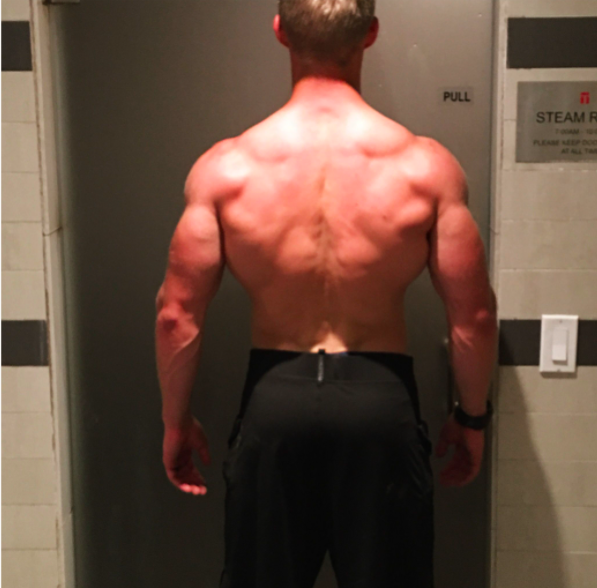Three Problems with Your Bent Over Row
May 12, 2021
The barbell bent over row is one of the best muscle-building exercises around. Rows help you build can do to build thick slabs of muscle to support every strength movement and build a powerful physique.
The barbell bent-over row requires you to perform a hip hinge and isometrically hold a neutral spine position.
This builds incredible strength and resiliency through your core stabilizers. Over time, this helps you to build an injury-resistant midsection and strength in hip-hinge patterns like deadlifts.
Barbell rows specifically build your lats, traps, and rhomboids to give you the vaunted v-tapered physique.

Your lats are a large muscle group with both vertical and horizontal muscle fiber orientation.
In other words, a purely horizontal row (seated row) or vertical pull (pull up) isn’t enough to train all fibers.
You’ll need to train your back through a variety of angles if you want to grow. The barbell bent-over row gives you the ability to hit numerous muscle fibers when you adjust the angle of your torso.
What muscle does the bent over row work?
Barbell bent-over rows also hammer your rear delts, traps, rhomboids, and to a lesser extent, your forearms and biceps.
With all these benefits, there’s no doubt you should row, right?
Like an awkward rehearsal dinner, there’s always the elephant in the room when it comes to exercise selection.
For barbell rows, the biggest draw-back is lower back health. Many lifters struggle to maintain a neutral spine position and lift too heavy on barbell rows. Instead of holding neutral spine position, they’re quickly dry-humping the bar in a feeble attempt to row.
When it comes to barbell rows you’re best off leaving your ego at the door, holding position, and only adding weight once you’ve perfected your technique.
For optimal health and performance, emphasize building stability through your trunk during your bent-over rows.
Holding this position will challenging your hamstrings, glutes, spinal erectors, and core to hold position and build brutal strength.
Barbell bent-over rows are a great exercise to address common technique weaknesses and flaws, such as trunk stability and strength in the hinge position.
Here are three problems with your bent-over row to help you minimize your risk of injury and maximize your gains.
Potential Issues with the Bent Over Row
Losing Lower Back Position
Many lifters compensate through their lower back on barbell bent-over rows. You see this in two different ways:
- Extending the lower back to lift the weight. This takes the load off of your lats, traps, and rhomboids and places more emphasis on your lower back.
- Rounding your spine. To be blunt, the main reason lifters lose spinal position is they’re simply going too heavy. Losing spinal position puts the disks and ligaments of your spine in a precarious position. If you cannot control spinal position during barbell rows, lighten up or use a different exercise. When it comes to your programming you need to be conservative when programming barbell rows with squats and deadlifts due to the cumulative stress on your spine.Related: Low Back Pain Stretches
Pulling the Body to the Bar:
Let your muscles lift the weight, not your ego. Most lifters tend to excessively load the bar and end up using way too much momentum to move the weight.
While the intentions are good, losing position, raising the chest, flexing the spine, and doing total body convulsions to complete the lift do more harm than good.
The remedy to this problem is to reduce the weight, slow down, and own joint position.
Pulling the Elbows Too far Back:
When rowing, some lifters pull the bar too far past mid-line. While you might feel a better “squeeze” in the muscles, the humerus may migrate forward into the anterior socket of the shoulder, potentially causing impingement and dysfunction.
Rather than driving the elbows as far as possible, aim to break the plane of the body, but no further if the shoulder caves forward.
This way, you’ll optimize muscular recruitment for gains in strength and size without compromising the integrity of the shoulder joint.
You’ll still get jacked without harming your shoulders.
How To Do Barbell Bent Over Rows
Below is a breakdown of checks and balances for your barbell bent-over rows.
A few key pointers:
Keep neutral spine position.
Pull your elbows back until you reach 90 degrees. Going further pushes your shoulder into an anterior-humeral glide, which can cause issues.
Control your tempo and feel your muscles squeeze. The mind-muscle connection is crucial for building lean muscle, particularly on more systemically stressful exercises like barbell rows.
Barbell Bent Over Row Starting Position:
The barbell row starting position should be similar to your deadlift position. The barbell should be at or close to your shins. Your spine should be in a neutral position. When you pick up the bar, your core should be engaged.
Bent Over Row Hand Position
You have two options for barbell row hand position:
1. Pronated, or overhand grip. This grip is more challenging and will hit your forearm flexors harder.
2. Supinated, or underhand grip. The supinated grip will allow you to train heavier and stress your biceps. But reps must be done under control to reduce the chance of a biceps tear.
Torso Angle
In both videos above you can see my torso is held at a 30-45 degree angle. You can vary slightly from this position as long as you maintain a neutral spine position. It’s best to experiment with a few different angles to see what is most comfortable and where you can feel your lats optimally engage.
Barbell Bent Over Row
But, every exercise is a tool, and any tool is only as good as its use. Troubleshoot your row and ensure you’re not making errors to the detriment of your health, function, and physique.
P.S. Looking for a proven method to look great naked without living in the gym?
Grab a limited edition copy of our One Hour Body Guide Today:










[…] Three Problems With your Bent Over Row via Eric Bach […]
[…] 3 Problems With Your Bent Over Row via Eric Bach […]
[…] Three Problems with Your Bent Over Row – Eric Bach […]
[…] https://bachperformance.com/three-concerns-bent-row/ […]